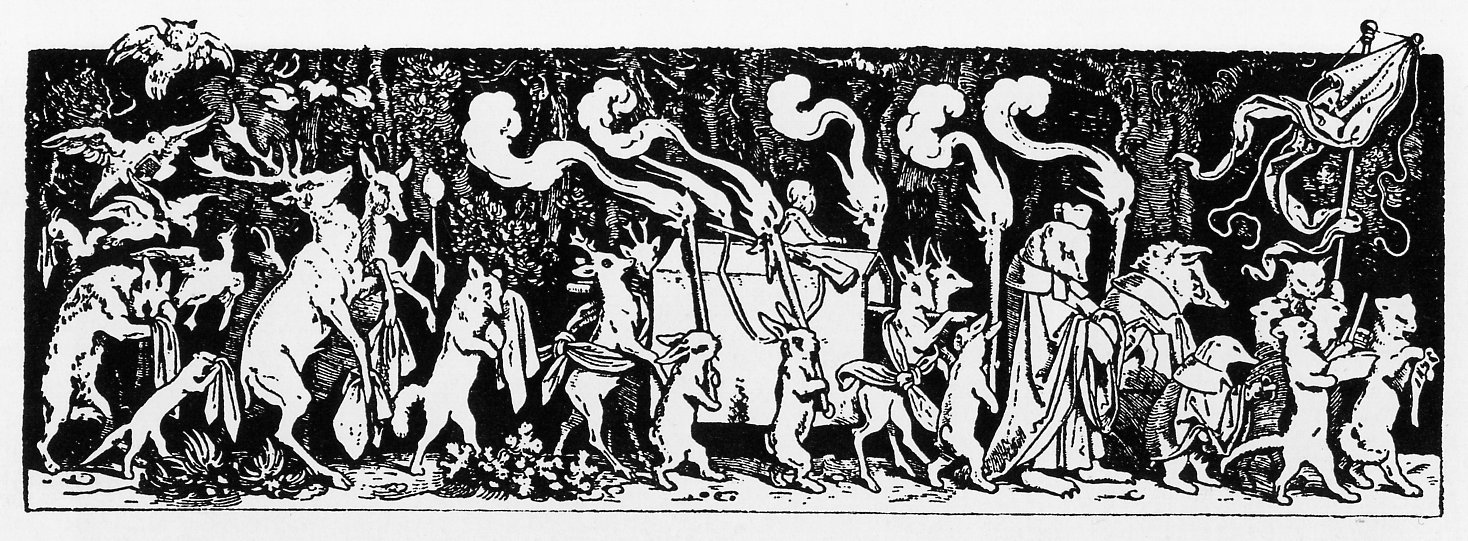Funeral March Movement Analysis
Third Movement: 'Funeral March in Callot's Manner'
The third movement acts as the slow movement of the symphony’s four movement structure. The extra-musical idea inspiring the movement is taken from The Hunter’s Funeral, an old Austrian folk story.
Mahler described the movement in a conversation with Bauer-Lechner in November 1900: "On the surface one might imagine this scenario: A funeral procession passes by our hero, and the misery, the whole distress of the world, with its cutting contrasts and horrible irony, grasps him. The funeral march of "Brother Martin" one has to imagine as being played in a dull manner by a band of very bad musicians, as they usually follow such funeral processions. The roughness, gaiety, and banality of this world then appears in the sounds of some interfering Bohemian musicians, heard at the same time as the terribly painful lamentation of the hero. It has a shocking effect in its sharp irony and inconsiderate polyphony, especially when we see the procession returning from the funeral (after the beautiful middle section), and the funeral band starts to play the usual happy tune (which pierces here to the bone)." In 1901 Mahler wrote in a letter to Bernhard Schuster: "the third movement... is heart-rending, tragic irony and is to be understood as exposition and preparation for the sudden outburst in the final movement of despair of a deeply wounded and broken heart."
The movement begins with the timpani softly beating a two note ostinato in isolation:
![]()
(MP3 Format)
Mahler gives directions in the score: "Solemn and measured without dragging". After two bars, the main melodic theme forming the basis of the movement is introduced on a solo Contrabass, an innovative role for the instrument.


(MP3 Format)
Mahler reproduced this melody note for note from the popular round "Bruder Martin" (Brother Martin), also known as ‘Frère Jacques’ described by August Beer as "a humorous round sung in Germany by male choirs and young men in pubs in a jocular, chanting manner." The canon section (bars 1-38) slowly builds momentum as the round is picked up by different instruments in a highly unusual order, jumping from different sections of the orchestra resulting in timbre combinations that are characteristically Mahler:
| Bar: 3 | Double-bass solo |
| 11 | Muted cellos |
| 15 | Bass tuba |
| 17 | First bassoon & first clarinet |
| 19 | Muted violas |
| 21 | First horn |
| 23 | Four flutes |
| 25 | English horn, two clarinets, & bass clarinet |
| 27 | Violas & cellos one octave apart |
| 29 | Four muted horns & harp |
In a conversation with Natalie Bauer-Lechner, Mahler stated: "in the round, the new entrance always is distinct, in a surprising timbre, drawing attention to itself."
The oboe introduces the following counter melody in bar 19, which is heard again in bar 29 with the addition of the E-flat clarinet (The first appearance of the instrument in the symphony):

(MP3 Format)
Mahler then introduces a new section lasting from bar 39-44. The oboe is given a swaying melody in thirds and sixths (See Pic below) with the trumpets providing a counter melody underneath. This counter melody continues into the parody section acting as a bridge between the contrasting ‘Bruder Martin’ opening and Parody section which follows.

(MP3 Format)
The unexpected parody section (bars 45-49 & 57-60) includes the following novel instrumentation resembling a Klezmer band: Turkish cymbals, bass drum, oboes, clarinets, flutes and a trumpet duo with the strings giving an unsophisticated accompaniment.
Mahler hints at a return to the canon (bars 70-81), but instead establishes the third more reflective section (bar 81-112) which uses material found in the final stanza of the fourth song from Lieder eines fahrenden Gesellen, "Die zwei blauen Augen von meinem Schatz" ("The Two Blue Eyes of My Beloved"). Read the lyrics of the lieder.
A return to the canon is made in bar 113 this time played in E-flat minor as opposed to D minor as it is found in the beginning, it modulates back to the distant key of D minor in 139.
Mahler’s impressive contrapuntal technique is exhibited in the penultimate section of the movement where he interweaves three previously introduced thematic elements simultaneously on top of each other (bar 139) with the direction: plötzlich viel schneller (suddenly much faster). The despairing canon "Bruder Martin" is set against the cheerful parody melody, demonstrating the painful coexistence of tragedy and triviality in life, a theme Mahler would continue to explore in later works. The intertwining elements gradually unravel and the movement comes to a slow conclusion with alternating fourths, the unifying motive underlying the symphony, played in the lower strings.
The slow movement of Mahler’s first symphony skillfully switches from one extreme mood to another without giving the impression of a break. Mahler wrote of the movements ambivalent nature: "as an expression of a sometimes ironic and happy and sometimes eerie and brooding mood." The novel instrumentation, impressive counterpoint, construction of the climax, all exemplify Mahler’s ingenuity and technical prowess.
